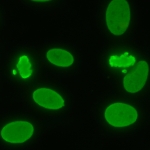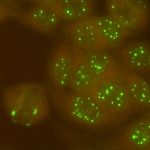| Code | Pattern | Previous Nomenclature | Description |
|---|
















































The Topo I-like pattern can comprise staining of five subcellular regions:
1) Prominent fine speckled nuclear staining in interphase cells.
2) Consistent strong fine speckled staining of condensed chromatin in mitotic cells. Depending on the serum dilution used, the mitotic chromatin staining may appear homogeneous.
3) Strong staining of nucleolar organizing region (NOR).
4) Delicate and weak cytoplasmic weblike staining radiating from the perinuclear area to the vicinity of plasma membrane (in general, the cytoplasmic staining becomes more prominent during titering the sample to higher dilutions.
5) Inconsistent nucleolar staining that can appear as a punctate nucleolar or perinucleolar staining in interphase cells. Nucleolar staining is not a universal feature of this pattern.
See Andrade et al. for full discussion (Clin Chem Lab Med. 2018;56:1783-8.)